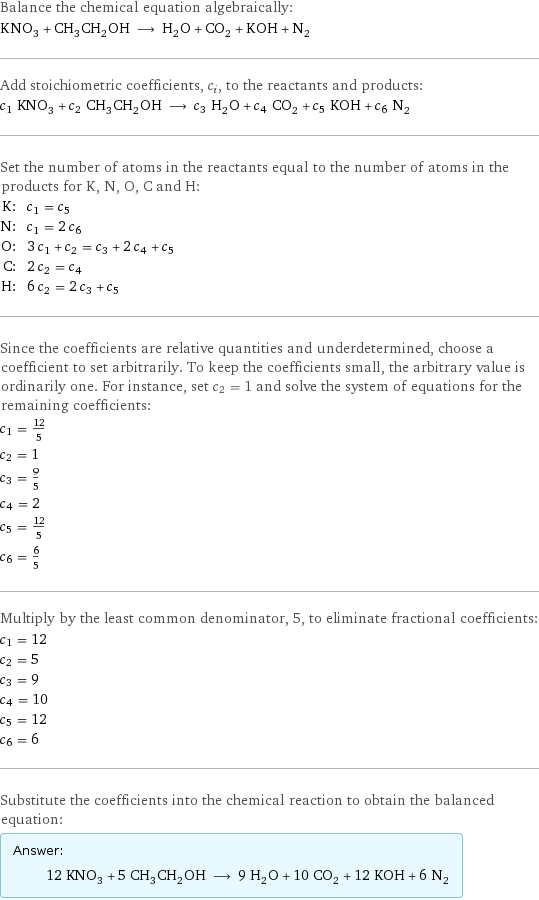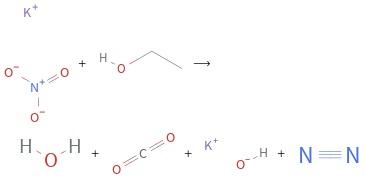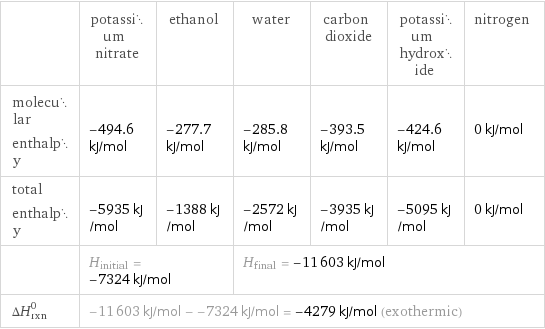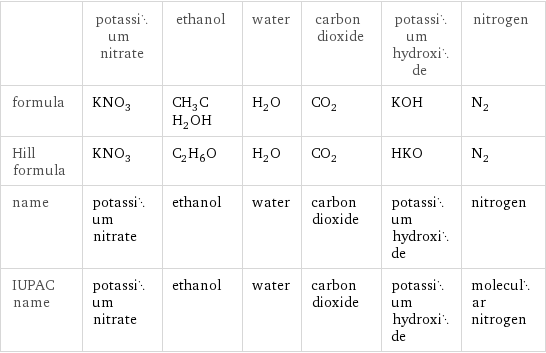Input interpretation

KNO_3 potassium nitrate + CH_3CH_2OH ethanol ⟶ H_2O water + CO_2 carbon dioxide + KOH potassium hydroxide + N_2 nitrogen
Balanced equation

Balance the chemical equation algebraically: KNO_3 + CH_3CH_2OH ⟶ H_2O + CO_2 + KOH + N_2 Add stoichiometric coefficients, c_i, to the reactants and products: c_1 KNO_3 + c_2 CH_3CH_2OH ⟶ c_3 H_2O + c_4 CO_2 + c_5 KOH + c_6 N_2 Set the number of atoms in the reactants equal to the number of atoms in the products for K, N, O, C and H: K: | c_1 = c_5 N: | c_1 = 2 c_6 O: | 3 c_1 + c_2 = c_3 + 2 c_4 + c_5 C: | 2 c_2 = c_4 H: | 6 c_2 = 2 c_3 + c_5 Since the coefficients are relative quantities and underdetermined, choose a coefficient to set arbitrarily. To keep the coefficients small, the arbitrary value is ordinarily one. For instance, set c_2 = 1 and solve the system of equations for the remaining coefficients: c_1 = 12/5 c_2 = 1 c_3 = 9/5 c_4 = 2 c_5 = 12/5 c_6 = 6/5 Multiply by the least common denominator, 5, to eliminate fractional coefficients: c_1 = 12 c_2 = 5 c_3 = 9 c_4 = 10 c_5 = 12 c_6 = 6 Substitute the coefficients into the chemical reaction to obtain the balanced equation: Answer: | | 12 KNO_3 + 5 CH_3CH_2OH ⟶ 9 H_2O + 10 CO_2 + 12 KOH + 6 N_2
Structures

+ ⟶ + + +
Names

potassium nitrate + ethanol ⟶ water + carbon dioxide + potassium hydroxide + nitrogen
Reaction thermodynamics
Enthalpy

| potassium nitrate | ethanol | water | carbon dioxide | potassium hydroxide | nitrogen molecular enthalpy | -494.6 kJ/mol | -277.7 kJ/mol | -285.8 kJ/mol | -393.5 kJ/mol | -424.6 kJ/mol | 0 kJ/mol total enthalpy | -5935 kJ/mol | -1388 kJ/mol | -2572 kJ/mol | -3935 kJ/mol | -5095 kJ/mol | 0 kJ/mol | H_initial = -7324 kJ/mol | | H_final = -11603 kJ/mol | | | ΔH_rxn^0 | -11603 kJ/mol - -7324 kJ/mol = -4279 kJ/mol (exothermic) | | | | |
Gibbs free energy

| potassium nitrate | ethanol | water | carbon dioxide | potassium hydroxide | nitrogen molecular free energy | -394.9 kJ/mol | -174.8 kJ/mol | -237.1 kJ/mol | -394.4 kJ/mol | -379.4 kJ/mol | 0 kJ/mol total free energy | -4739 kJ/mol | -874 kJ/mol | -2134 kJ/mol | -3944 kJ/mol | -4553 kJ/mol | 0 kJ/mol | G_initial = -5613 kJ/mol | | G_final = -10631 kJ/mol | | | ΔG_rxn^0 | -10631 kJ/mol - -5613 kJ/mol = -5018 kJ/mol (exergonic) | | | | |
Equilibrium constant
![Construct the equilibrium constant, K, expression for: KNO_3 + CH_3CH_2OH ⟶ H_2O + CO_2 + KOH + N_2 Plan: • Balance the chemical equation. • Determine the stoichiometric numbers. • Assemble the activity expression for each chemical species. • Use the activity expressions to build the equilibrium constant expression. Write the balanced chemical equation: 12 KNO_3 + 5 CH_3CH_2OH ⟶ 9 H_2O + 10 CO_2 + 12 KOH + 6 N_2 Assign stoichiometric numbers, ν_i, using the stoichiometric coefficients, c_i, from the balanced chemical equation in the following manner: ν_i = -c_i for reactants and ν_i = c_i for products: chemical species | c_i | ν_i KNO_3 | 12 | -12 CH_3CH_2OH | 5 | -5 H_2O | 9 | 9 CO_2 | 10 | 10 KOH | 12 | 12 N_2 | 6 | 6 Assemble the activity expressions accounting for the state of matter and ν_i: chemical species | c_i | ν_i | activity expression KNO_3 | 12 | -12 | ([KNO3])^(-12) CH_3CH_2OH | 5 | -5 | ([CH3CH2OH])^(-5) H_2O | 9 | 9 | ([H2O])^9 CO_2 | 10 | 10 | ([CO2])^10 KOH | 12 | 12 | ([KOH])^12 N_2 | 6 | 6 | ([N2])^6 The equilibrium constant symbol in the concentration basis is: K_c Mulitply the activity expressions to arrive at the K_c expression: Answer: | | K_c = ([KNO3])^(-12) ([CH3CH2OH])^(-5) ([H2O])^9 ([CO2])^10 ([KOH])^12 ([N2])^6 = (([H2O])^9 ([CO2])^10 ([KOH])^12 ([N2])^6)/(([KNO3])^12 ([CH3CH2OH])^5)](../image_source/457619ddff5132ef957fc872a6e0b450.png)
Construct the equilibrium constant, K, expression for: KNO_3 + CH_3CH_2OH ⟶ H_2O + CO_2 + KOH + N_2 Plan: • Balance the chemical equation. • Determine the stoichiometric numbers. • Assemble the activity expression for each chemical species. • Use the activity expressions to build the equilibrium constant expression. Write the balanced chemical equation: 12 KNO_3 + 5 CH_3CH_2OH ⟶ 9 H_2O + 10 CO_2 + 12 KOH + 6 N_2 Assign stoichiometric numbers, ν_i, using the stoichiometric coefficients, c_i, from the balanced chemical equation in the following manner: ν_i = -c_i for reactants and ν_i = c_i for products: chemical species | c_i | ν_i KNO_3 | 12 | -12 CH_3CH_2OH | 5 | -5 H_2O | 9 | 9 CO_2 | 10 | 10 KOH | 12 | 12 N_2 | 6 | 6 Assemble the activity expressions accounting for the state of matter and ν_i: chemical species | c_i | ν_i | activity expression KNO_3 | 12 | -12 | ([KNO3])^(-12) CH_3CH_2OH | 5 | -5 | ([CH3CH2OH])^(-5) H_2O | 9 | 9 | ([H2O])^9 CO_2 | 10 | 10 | ([CO2])^10 KOH | 12 | 12 | ([KOH])^12 N_2 | 6 | 6 | ([N2])^6 The equilibrium constant symbol in the concentration basis is: K_c Mulitply the activity expressions to arrive at the K_c expression: Answer: | | K_c = ([KNO3])^(-12) ([CH3CH2OH])^(-5) ([H2O])^9 ([CO2])^10 ([KOH])^12 ([N2])^6 = (([H2O])^9 ([CO2])^10 ([KOH])^12 ([N2])^6)/(([KNO3])^12 ([CH3CH2OH])^5)
Rate of reaction
![Construct the rate of reaction expression for: KNO_3 + CH_3CH_2OH ⟶ H_2O + CO_2 + KOH + N_2 Plan: • Balance the chemical equation. • Determine the stoichiometric numbers. • Assemble the rate term for each chemical species. • Write the rate of reaction expression. Write the balanced chemical equation: 12 KNO_3 + 5 CH_3CH_2OH ⟶ 9 H_2O + 10 CO_2 + 12 KOH + 6 N_2 Assign stoichiometric numbers, ν_i, using the stoichiometric coefficients, c_i, from the balanced chemical equation in the following manner: ν_i = -c_i for reactants and ν_i = c_i for products: chemical species | c_i | ν_i KNO_3 | 12 | -12 CH_3CH_2OH | 5 | -5 H_2O | 9 | 9 CO_2 | 10 | 10 KOH | 12 | 12 N_2 | 6 | 6 The rate term for each chemical species, B_i, is 1/ν_i(Δ[B_i])/(Δt) where [B_i] is the amount concentration and t is time: chemical species | c_i | ν_i | rate term KNO_3 | 12 | -12 | -1/12 (Δ[KNO3])/(Δt) CH_3CH_2OH | 5 | -5 | -1/5 (Δ[CH3CH2OH])/(Δt) H_2O | 9 | 9 | 1/9 (Δ[H2O])/(Δt) CO_2 | 10 | 10 | 1/10 (Δ[CO2])/(Δt) KOH | 12 | 12 | 1/12 (Δ[KOH])/(Δt) N_2 | 6 | 6 | 1/6 (Δ[N2])/(Δt) (for infinitesimal rate of change, replace Δ with d) Set the rate terms equal to each other to arrive at the rate expression: Answer: | | rate = -1/12 (Δ[KNO3])/(Δt) = -1/5 (Δ[CH3CH2OH])/(Δt) = 1/9 (Δ[H2O])/(Δt) = 1/10 (Δ[CO2])/(Δt) = 1/12 (Δ[KOH])/(Δt) = 1/6 (Δ[N2])/(Δt) (assuming constant volume and no accumulation of intermediates or side products)](../image_source/3fc8fd8f36907de4386feae766ecc28b.png)
Construct the rate of reaction expression for: KNO_3 + CH_3CH_2OH ⟶ H_2O + CO_2 + KOH + N_2 Plan: • Balance the chemical equation. • Determine the stoichiometric numbers. • Assemble the rate term for each chemical species. • Write the rate of reaction expression. Write the balanced chemical equation: 12 KNO_3 + 5 CH_3CH_2OH ⟶ 9 H_2O + 10 CO_2 + 12 KOH + 6 N_2 Assign stoichiometric numbers, ν_i, using the stoichiometric coefficients, c_i, from the balanced chemical equation in the following manner: ν_i = -c_i for reactants and ν_i = c_i for products: chemical species | c_i | ν_i KNO_3 | 12 | -12 CH_3CH_2OH | 5 | -5 H_2O | 9 | 9 CO_2 | 10 | 10 KOH | 12 | 12 N_2 | 6 | 6 The rate term for each chemical species, B_i, is 1/ν_i(Δ[B_i])/(Δt) where [B_i] is the amount concentration and t is time: chemical species | c_i | ν_i | rate term KNO_3 | 12 | -12 | -1/12 (Δ[KNO3])/(Δt) CH_3CH_2OH | 5 | -5 | -1/5 (Δ[CH3CH2OH])/(Δt) H_2O | 9 | 9 | 1/9 (Δ[H2O])/(Δt) CO_2 | 10 | 10 | 1/10 (Δ[CO2])/(Δt) KOH | 12 | 12 | 1/12 (Δ[KOH])/(Δt) N_2 | 6 | 6 | 1/6 (Δ[N2])/(Δt) (for infinitesimal rate of change, replace Δ with d) Set the rate terms equal to each other to arrive at the rate expression: Answer: | | rate = -1/12 (Δ[KNO3])/(Δt) = -1/5 (Δ[CH3CH2OH])/(Δt) = 1/9 (Δ[H2O])/(Δt) = 1/10 (Δ[CO2])/(Δt) = 1/12 (Δ[KOH])/(Δt) = 1/6 (Δ[N2])/(Δt) (assuming constant volume and no accumulation of intermediates or side products)
Chemical names and formulas

| potassium nitrate | ethanol | water | carbon dioxide | potassium hydroxide | nitrogen formula | KNO_3 | CH_3CH_2OH | H_2O | CO_2 | KOH | N_2 Hill formula | KNO_3 | C_2H_6O | H_2O | CO_2 | HKO | N_2 name | potassium nitrate | ethanol | water | carbon dioxide | potassium hydroxide | nitrogen IUPAC name | potassium nitrate | ethanol | water | carbon dioxide | potassium hydroxide | molecular nitrogen